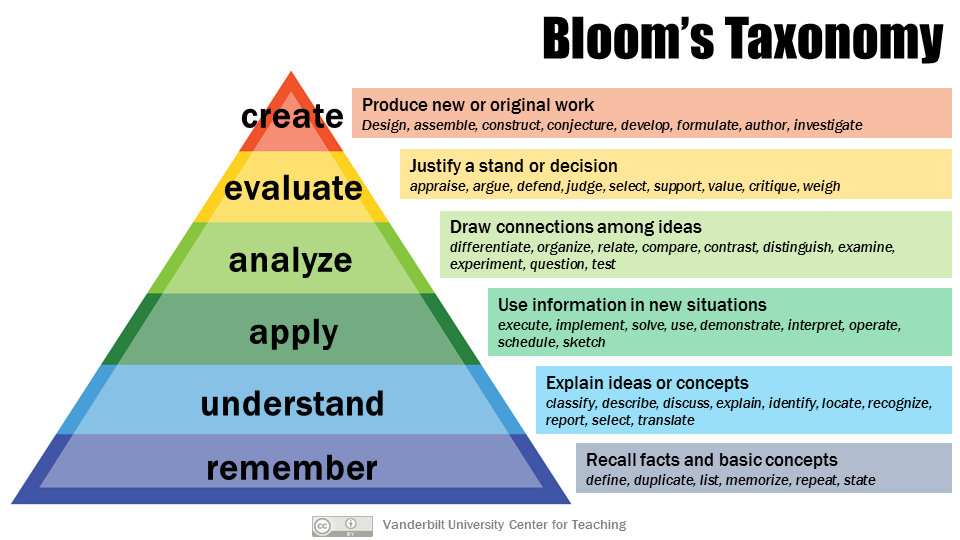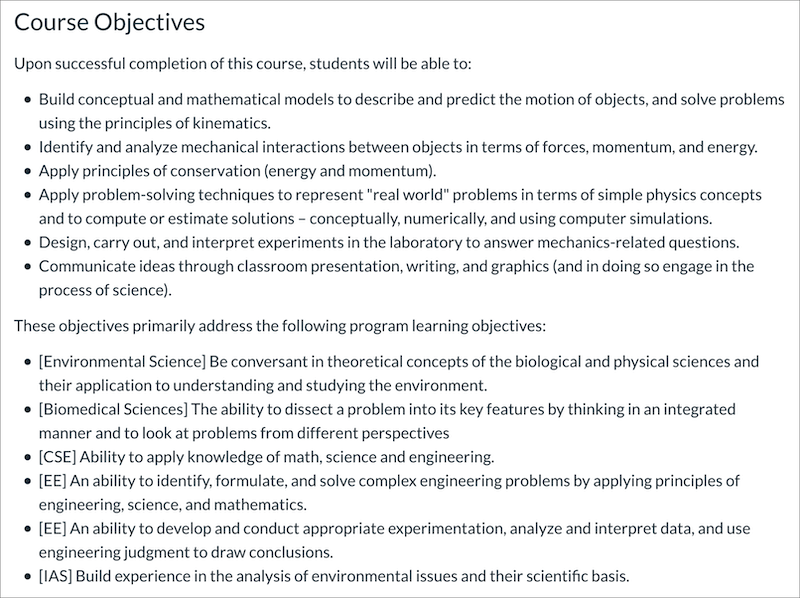Main Content
Topic Overview
Quality Learning Objectives
Devising high-quality learning objectives is crucial to both building your course and its effectiveness for students. A high-quality learning objective is specific and measurable, which means it is necessarily based on a performance, or something a learner does.
As defined by the Quality Matters Rubric, a highly regarded tool for evaluating online and hybrid course quality, a quality objective will also be "aligned," meaning it fits into a cooperative chain of course-level and module/unit-level objectives supported by connected learning materials, activities, and assessments.
The SMART model encapsulates effective objectives in a particularly clear way:
Expand Your Knowledge
SMART Objectives
The SMART model for writing objectives is simple to remember and useful. SMART refers to objectives that are:
Specific objectives use clear and direct language describing what your students will learn and, most important, do.
Measurable objectives are those with actions and/or products you can observe and assess. The most common mistake with learning objectives is using cognitive domains like "know," "learn," or "understand," which are not measurable, instead of action verbs describing specific, assessable performances.
Achievable (or Attainable) objectives are those a student has a reasonable opportunity to complete with their given knowledge, time, and resources.
Relevant objectives are clearly connected to the course outcomes and content and well-aligned.
Timely objectives are those that are in the right place in the sequence of the course, have understood time limits or expectations, and (where possible) contribute to the field or workplace of the student.
For example, here are some sample objectives that are SMART and not-so-SMART:
| not-so-SMART | SMART |
| Know how leavened baked goods rise |
Identify common leavening agents Document the advantages and disadvantages of different leavening agents |
| Learn how to bake basic French bread | Bake a loaf of no-knead French bread |
| Understand the difference between French and Italian bread | Distinguish French from Italian breads using a table or an infographic |
| Know the basics of common baking equipment | Describe common baking equipment used to produce leavened bread |
Bloom's Taxonomy
Bloom's Taxonomy is a well regarded model for classifying learning objectives into different types and levels of complexity. There are other models, even some that are arguably better for thinking about your course overall (such as Fink's Taxonomy of Significant Learning, but Bloom's is sensible and has the added benefit of being an explicit part of the Quality Matters approach.
As you write your SMART learning objectives, consider how they fit into Bloom's taxonomy. This will not only give you some ideas for the action verb part of your objectives, but will also assist you in considering whether your module and course contain an appropriate breadth of objective types.
A quality module will contain objectives of multiple (but rarely all!) types; a quality course will typically address all types at some point.
Below, see a nice visualization of the taxonomy along with some action verbs that are typically, but not strictly, associated with each part of the taxonomy (helpful as you compose your learning objectives):

For an extensive list of action verbs often associated with each type, see this Bloom’s Taxonomy Verb Chart.
Objectives and Alignment
At the heart of Quality Matters, and perhaps the most important pedagogical aspect of any course, is alignment. Even if you aren't planning to have your course formally reviewed, ensuring alignment is an important task.
What Alignment Is
Alignment refers to the way in which each of the elements of your course work together to support the intended learning outcomes. When you have the alignment of your course elements figured out, you will naturally have a framework for your course.
You can think of alignment as a kind of chain in which the materials, activities, and assessments in your course support the learning objectives of each module, and each module in turn supports the course-level objectives. The manner in which each part of your course supports the next is through alignment.
Course-level learning objectives
Course-level objectives:
- May be defined by the school or program in which your course is located
- Describe what students will be able to do (and will have done) when they finish the course
- Will naturally be broad and achievable only in the longer term (the duration of the course)
Module-level learning objectives
Module-level objectives:
- Will usually be defined by you
- Describe what students will be able to do (and will have done) within a module
- Will be specific to the module and achievable in the short term (the duration of a module)
Why Alignment Matters
This isn't just a conceptual concern; alignment must be explicitly addressed in the way you build your course. For each module in your course you will need to define learning objectives, to which everything in that module is expected to contribute: every reading, every activity, every project, and every assessment.
Even if you have no interest in Quality Matters certification, it remains the framework for online and hybrid courses at UWT. More importantly, alignment in your course is important to both you and your students for a variety of reasons:
- For you, alignment provides a method for determining what is important and appropriate in your course, and assures that everything your students do is connected to the course's learning outcomes. Alignment allows you to remove things that might be traditional or inherited but don't clearly connect to the intended outcomes, and to add materials, activities, and assessments that do. Finally, alignment exposes clearly what to assess (and when).
- For your students, alignment assures them that their effort is maximized in service of learning and that the purpose of their work is clear.
Key QM Standards
If you look at the Quality Matters Rubric, you will see that alignment is fundamental to many of the critical standards. In particular:
- 2.1 Course objectives are measurable
- 2.2 Module objectives are measurable
- 3.1 Assessments measure objectives?
- 4.1 Materials contribute to the objectives.
- 5.1 Activities promote achievement of objectives.
- 6.1 Tools used support the objectives.
An Example
- Course Level Objective: Create and bake French, Italian and Soft sandwich breads.
- Module Objective: Calculate hydration levels
- Module Objective: Create and pre-ferment a "sponge"
- Module Objective: Bake a free-form French loaf
- Materials: Hydration calculation and calculator (site)
- Materials: Video on yeast types
- Materials: Video on different types of unsweet yeast breads
- Activity: Hydration calculation practice using given values
- Assessment: Hydration calculation quiz (auto-graded)
- Activity: Create and bake Loaf
- Activity: Select and share recipe, including reasons for choosing it
- Assessment: Submit baking journal
- Activity: graded discussion sharing pictures of product and notes about challenges and ongoing questions
- Activity: Hydration calculation practice using given values
Applying Key Concepts
Once you have quality learning objectives created, you will want to share them with your students. The most common locations, and those your students will likely expect, are:
- Program and Course Objectives: on the Syllabus page (and in your full Syllabus, if you share a single file)
- Module/Unit Objectives: at the head of each module or unit.
For example, Dr. Allen Olson lists the Course and specific Program Objectives, on his Canvas Syllabus pages:

And his objectives, in a narrative form, at the top of each module:

Dr. Stephen Ross includes learning objectives as a list at the top of each module.
Check your Learning
Course-Level Objectives
If your course has predefined course objectives or outcomes:
- Confirm that your course-level objectives are accurate on your Syllabus page
- Add any additional quality objectives, if you have or want any
If your course does not have predefined course objectives or outcomes, then you should
- Create your quality objectives, if you haven't already
- Confirm that your objectives appear on your Syllabus page
If you are unsure whether your course has predefined objectives, ask your department chair.
Module-Level Objectives
First, choose a unit from your course, preferably the first one, and draft SMART module-level learning objectives for it.
As you go, explicitly note how:
- Each of your learning objectives support one or more of your course-level objectives
- Each objective meets the SMART criteria
- Each of the readings, activities, discussion and assessment you have planned for that unit support one or more of the module-level learning objectives you are creating
